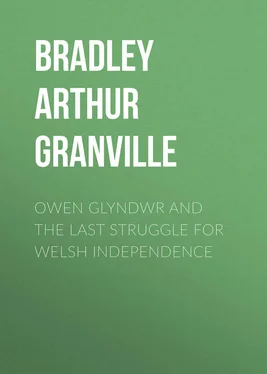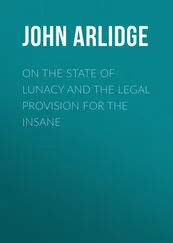Arthur Bradley - Owen Glyndwr and the Last Struggle for Welsh Independence
Здесь есть возможность читать онлайн «Arthur Bradley - Owen Glyndwr and the Last Struggle for Welsh Independence» — ознакомительный отрывок электронной книги совершенно бесплатно, а после прочтения отрывка купить полную версию. В некоторых случаях можно слушать аудио, скачать через торрент в формате fb2 и присутствует краткое содержание. Жанр: foreign_antique, foreign_prose, foreign_language, на английском языке. Описание произведения, (предисловие) а так же отзывы посетителей доступны на портале библиотеки ЛибКат.
- Название:Owen Glyndwr and the Last Struggle for Welsh Independence
- Автор:
- Жанр:
- Год:неизвестен
- ISBN:нет данных
- Рейтинг книги:5 / 5. Голосов: 1
-
Избранное:Добавить в избранное
- Отзывы:
-
Ваша оценка:
- 100
- 1
- 2
- 3
- 4
- 5
Owen Glyndwr and the Last Struggle for Welsh Independence: краткое содержание, описание и аннотация
Предлагаем к чтению аннотацию, описание, краткое содержание или предисловие (зависит от того, что написал сам автор книги «Owen Glyndwr and the Last Struggle for Welsh Independence»). Если вы не нашли необходимую информацию о книге — напишите в комментариях, мы постараемся отыскать её.
Owen Glyndwr and the Last Struggle for Welsh Independence — читать онлайн ознакомительный отрывок
Ниже представлен текст книги, разбитый по страницам. Система сохранения места последней прочитанной страницы, позволяет с удобством читать онлайн бесплатно книгу «Owen Glyndwr and the Last Struggle for Welsh Independence», без необходимости каждый раз заново искать на чём Вы остановились. Поставьте закладку, и сможете в любой момент перейти на страницу, на которой закончили чтение.
Интервал:
Закладка:
It is not only the ecclesiastical but also the secular divisions of Wales, that in a great measure date from these fifth and sixth centuries. The three chief Kingdoms, or Principalities, into which the country was apportioned, stand out from these days with consistent clearness till they are gradually broken into fragments by the Norman power: On the north was Gwynedd; in the centre, Powys; on the south, Deheubarth or South Wales. As St. David’s was the premier see of the four Welsh dioceses, so Gwynedd was even more markedly the first among the three Welsh Kingdoms. Its ruler, when a sufficiently strong man to enforce it, had a recognised right to the title of “Pendragon” and the lip homage of his brother princes. When a weak one, however, filled the precarious throne, any attempt to exact even such an empty tribute would have been a signal for a general outbreak.
Gwynedd included the present counties 1 1 The present counties of Wales were not in existence as such till after the final conquest by Edward I. Even then, as we shall see, only six were created; the larger part of the Principality retaining its feudal lordships until the reign of Henry VIII. There were ancient subdivisions of the three Welsh Kingdoms ruled over by petty Princes owing allegiance to their immediate overlord; and their names still survive in those of modern counties or districts. Ceredigion, for instance, remains as Cardigan, Morganwg as Glamorgan, while the vale of Edeyrnion and the county of Merioneth still preserve the memory of two sons of the conquering Cunedda. But the units of old Welsh delimitation were the “Cantrefs” and the “Commotes,” which even to this day are often used for purposes of description, as well as occasionally for ecclesiastical and political divisions. Of Cantrefs there would be something like three to the modern county, while each “Cantref” again consisted of two “Commotes.” Back
of Flint, Anglesey, Carnarvon, and most of Merioneth, together with the northern part of Denbighshire.
Powys cannot be so readily defined in a line or two, but, roughly speaking, it was a triangle or wedge driven through Central Wales to a point on the sea, with a wide base resting on the English border, the present county of Montgomery representing its chief bulk. Its capital was Pengwern or Shrewsbury, till the eighth century, when Offa, King of Mercia, enraged at the inroads of the Welsh, gathered together his whole strength and thrust them permanently back from the plains of Shropshire to the rampart of hills along whose crests he made the famous Dyke that bears his name. Thenceforward Mathraval, and subsequently Welshpool, became the abode of the Princes of Powys.
The Southern Kingdom, or Deheubarth, was also something of a triangle, but reversely placed to that of Powys, its point lying on the English border, and its broad base stretching along the Irish Sea from the mouth of the Dovey to the capes of Pembroke.
Of these three divisions, Powys, as will be obvious even from the brief and crude description of its boundaries here given, had the greatest difficulty in holding its own against both Saxon and Norman. South Wales, on the other hand, was the thorniest crown, for it included to a greater degree than the others semi-independent chieftains, such as those of Morganwg and Cardigan, who were inclined to pay their tributes and their homage only when their overlord, who held his Court at Dynevor on the Towy, was strong enough to enforce them.
Thus for nearly seven centuries there were separate sources of strife in Wales, and three distinct classes of warfare. First there came the meritorious defence of the country against Saxon, Dane, and Norman, in which, upon the whole, there was much creditable unanimity. Secondly, during the lulls from foreign invasion, there was almost constant strife between North and South, Powys holding as it were the balance of power between them. Lastly there were the purely provincial quarrels, when heady chieftains fell out with their superiors, as a form of entertainment to which South Wales, as I have already remarked, was peculiarly prone.
But, after all, it is not quite accurate to give such emphasis to the existence and definition of the three Kingdoms till the death of Roderic the Great in 877. Several kings had essayed with varying success to rule all Wales, but it was Roderic who with scanty foresight finally divided the country between his three sons, laying particular stress on the suzerainty of Gwynedd. The prevalent custom of gavelkind worked admirably, no doubt, in private life among the primitive Welsh, but when applied to principalities and to ambitious and bloodthirsty princelings the effect was usually disastrous. To mitigate the dangers of his unwise partition, Roderic ordained a scheme which would have proved of undoubted excellence if the practice had only been equal to the theory. This was to the effect that if any two of the Princes of Wales quarrelled, all three were to meet in conclave in the wild pass of Bwlch-y-Pawl, through which the present rough road from Bala to Lake Vyrnwy painfully toils. Here they were to settle their difficulties peacefully; and as it was presumed that only two would be parties to the quarrel, the third was to act as arbiter. For some centuries after this we know very well that the successive rulers of the three Kingdoms drenched Wales in blood with their quarrels, but no tradition remains of a single conference at this wild spot among the hills, where the infant Vyrnwy plunges down through heathery glens and woods of birch and oak to the most beautiful artificial lake perhaps in Christendom.
The sins of omission must of necessity be infinite in dealing with so vast a subject in so compressed a space, and sins of omission, if not confessed in detail, sometimes affect the accuracy of the whole. Something, for instance, ought to be said of the pastoral character, even in these early days, of all Wales, except perhaps Anglesey and West Carnarvon; of the tribal organisation and the laws of gavelkind; of the domestic and family nature of the Church, whose minor benefices at any rate were largely hereditary, and whose traditions were intensely averse to centralisation. Among other things to be noted, too, is that Cadvan, who flourished in the seventh century, is generally regarded as the first genuine King of Wales, just as Roderic, nearly three hundred years later, was the great decentraliser.
Another important date is that of 815, when a Saxon victory in Cornwall destroyed the last vestige of British independence in England. For hitherto the Britons of Wales had by no means regarded themselves as the mere defenders of the soil they occupied. Steeped in the prophecies of Merlin and his contemporaries, which assured them of the ultimate reconquest of the whole island of Britain, they still cherished dreams which may seem to us by the light of history vain enough, but in the opening of the ninth century they still fired the fancy of a proud, romantic, and warlike race.
Amid the conflicting evidence of rival chroniclers, Saxon and Welsh, it is not often easy to select the victors in the long series of bloody combats that continued throughout the centuries preceding the Norman Conquest. Whatever victories the Saxons gained, they were not much less barren than their defeats. Nominal conquests were sometimes made of the more vulnerable districts, but they were not long maintained. At the next upheaval such loose allegiance as had been wrung from the provincial ruler was repudiated without a moment’s thought, and often indeed the Saxons beyond the border found themselves in their turn fighting for hearth and home.
Читать дальшеИнтервал:
Закладка:
Похожие книги на «Owen Glyndwr and the Last Struggle for Welsh Independence»
Представляем Вашему вниманию похожие книги на «Owen Glyndwr and the Last Struggle for Welsh Independence» списком для выбора. Мы отобрали схожую по названию и смыслу литературу в надежде предоставить читателям больше вариантов отыскать новые, интересные, ещё непрочитанные произведения.
Обсуждение, отзывы о книге «Owen Glyndwr and the Last Struggle for Welsh Independence» и просто собственные мнения читателей. Оставьте ваши комментарии, напишите, что Вы думаете о произведении, его смысле или главных героях. Укажите что конкретно понравилось, а что нет, и почему Вы так считаете.












